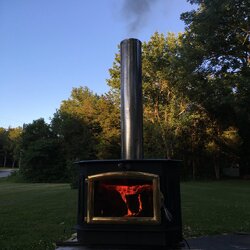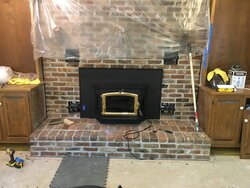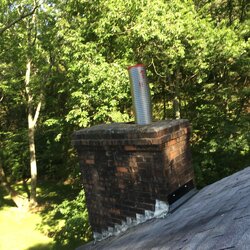We bought a house last spring in south central KY and have been doing a full remodel. It is a 2 story colonial with approx. 3100 sq ft. Fireplace is located on one end of the house. Downstairs is an open floorplan with 8 foot ceilings. We installed "Safe n Sound" insulation in the downstairs ceiling 2x8 joists and used fire rated Sheetrock for the ceiling. All walls are 2x8 studs with fiberglass insulation and vapor barrier. New Windows have been installed.
Ithe house had a 1982 Applachian 52 insert, but we have removed and just bought a slightly used 2006 model Buck 91. It has two electric heat pumps. With new rigid pipe ductwork and insulation.
We paid a chimney sweep to come while the Applachian Stove was still installed. Chimney was super clean, but it was a slammer install. He has quoted a $1600 price to install approximately 25 feet of 8" insulated pipe. He will also include a block-off plate.
Couple of issues:
1. The Buck 91 needs to be painted because of slight surface rust on the top of stove. What paint is recommended?
2. Should I attempt to install chimney liner myself? How much will I save?
3. Can anyone give me a good checklist for running a Buck 91? I would be willing to pay someone who has a Buck 91 to show me how to run it. I can come to you, or you to me.
4. What else do I need to know?
Thanks for the help!
Ithe house had a 1982 Applachian 52 insert, but we have removed and just bought a slightly used 2006 model Buck 91. It has two electric heat pumps. With new rigid pipe ductwork and insulation.
We paid a chimney sweep to come while the Applachian Stove was still installed. Chimney was super clean, but it was a slammer install. He has quoted a $1600 price to install approximately 25 feet of 8" insulated pipe. He will also include a block-off plate.
Couple of issues:
1. The Buck 91 needs to be painted because of slight surface rust on the top of stove. What paint is recommended?
2. Should I attempt to install chimney liner myself? How much will I save?
3. Can anyone give me a good checklist for running a Buck 91? I would be willing to pay someone who has a Buck 91 to show me how to run it. I can come to you, or you to me.
4. What else do I need to know?
Thanks for the help!


 That sounds like a good price for the liner install. The 91 is a good heater but it took me a while to get up to speed on running it efficiently. Read the manual, some good info there. You need 700-900 on the cat probe in order to get a solid cat light-off. As with any modern stove, you need DRY wood to get the bast performance. If the stove is cold, I'll burn a few medium-small sacrificial splits to get stove temp up before loading full. I've posted in a few Buck 91 threads on how I load and run the stove but I'm having a hard time finding a good post that covers my procedure but isn't too wordy...maybe there are none.
That sounds like a good price for the liner install. The 91 is a good heater but it took me a while to get up to speed on running it efficiently. Read the manual, some good info there. You need 700-900 on the cat probe in order to get a solid cat light-off. As with any modern stove, you need DRY wood to get the bast performance. If the stove is cold, I'll burn a few medium-small sacrificial splits to get stove temp up before loading full. I've posted in a few Buck 91 threads on how I load and run the stove but I'm having a hard time finding a good post that covers my procedure but isn't too wordy...maybe there are none.  Here's one recent reply I posted on how to control the burn if the stove wants to run hot:
Here's one recent reply I posted on how to control the burn if the stove wants to run hot: 

